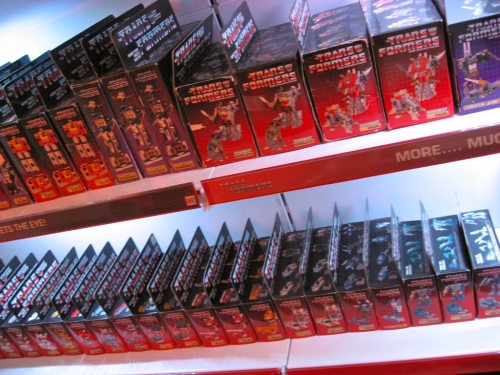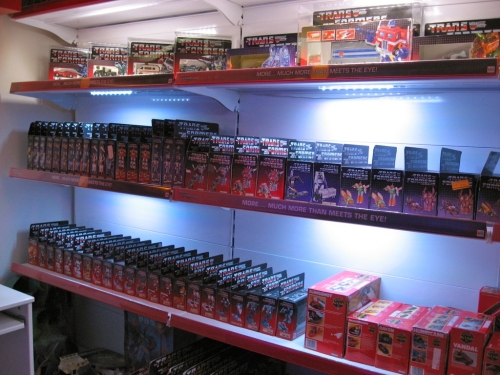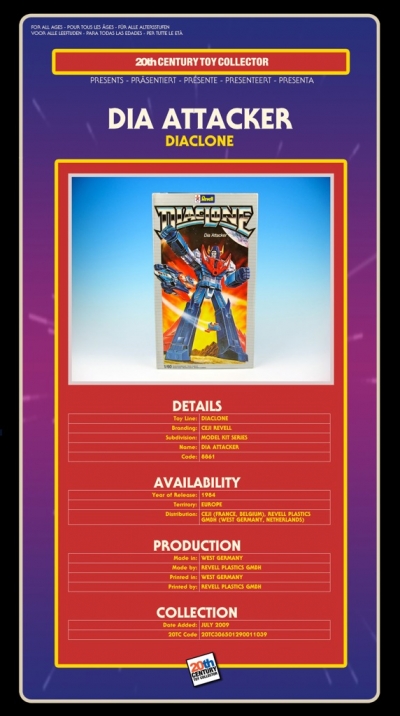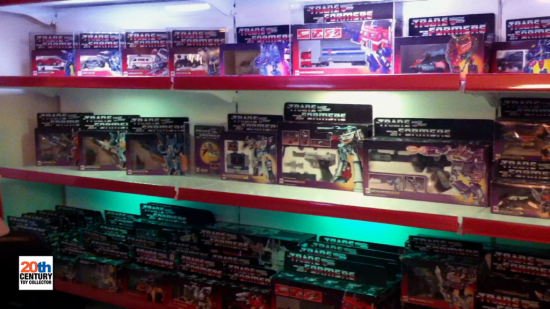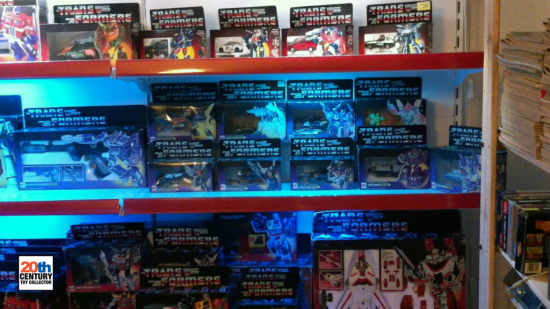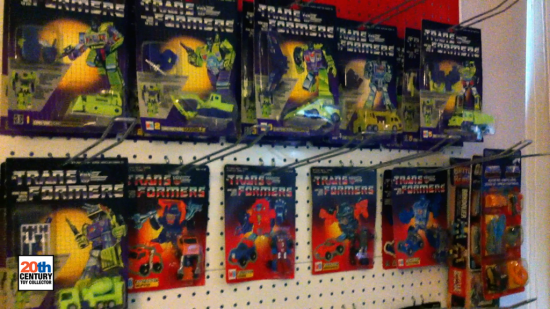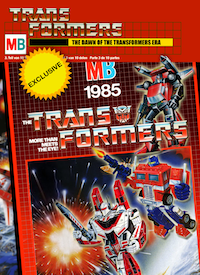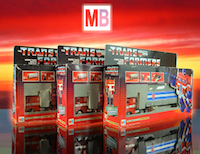Whenever you’re serious about collecting something (anything) and you stick to it, chances are that one day you’ll end up with a sizeable collection, which can create several challenges. One of these is that you can have so much stuff that it’s hard to keep track of everything. Another is that your collection becomes an investment. It represents an investment of time and money and if you collect vintage stuff the monetary value of your collection can easily become something you cannot ignore. Vintage toy collections can easily represent values of thousands and even tens of thousands of euros/dollars (and beyond!)
Expensive… :-)
When you reach that point it is probably wise that you start thinking about taking out an insurance on your collection. What if your house burns down one day? Your regular contents insurance is probably not going to cover the complete value of your collection, especially if it’s worth more than a couple of thousand euros. Yeah, it’s not something you’d like to think about and most of us would rather keep our collections instead of getting the monetary equivalent in case of a disaster, but if it does happen, at least you’ll have that.
“Peace of Mind”
In most countries you’ll be able to insure your vintage toy collection. You will probably have to contact your insurance company to work something out, because most of them do not offer specific vintage toy collection insurance products (although some might, depending on where you live, google around!). One thing that will definitely help you out when trying to insure your collection is to have a comprehensive record of all your acquisitions. By that I mean records of the payments that you made for all your items (e.g. PayPal records), where you got the items from, photographs of the items etc. This will act as proof and will help immensely in allowing the insurance company to determine an accurate value of your collection.

You can keep those records in any way you want as long as they are easily accessible. A spreadsheet application like Excel on Windows or Numbers on Mac OS X is a very good tool, but you could even use something like Notepad. It doesn’t really matter. As long as you have some records that can be traced back to your acquisitions.
“Keeping Track”
I’ve been keeping records meticulously for several years now. I’ve kept all the emails that have anything to do with my acquisitions and the price I paid for these (eBay emails, PayPal emails, communications with sellers) and I have been registering all this info in a spreadsheet on my computer. As you may be well aware I have also made numerous photographs of most items in my collection, which can be found throughout this website. Incurance companies love that stuff. The more evidence you have that you own something and what you paid for it, the more forthcoming they will be in selling you an insurance for your collection. It saves them the hassle of trying to determine the value of your collection (which is often not their field of expertise) and works in your favour, because you’ll be able to insure your collection at precise value and will give you peace of mind.
“Caveats”
Here’s some extra important information you should be aware of, which was kindly supplied by readers of this post in the comments section. First of all, make sure that you know how much your insurance company is going to pay you if and when disaster should strike. A lot of insurance policies assume you have objects in your house that depreciate in value, i.e. they become worth less and less as time goes by. That goes for a lot of things like your TV, your computer, your furniture, you name it. Most items that you buy will depreciate in value over time and insurance companies will often pay you either the original price you paid, or, if the item has depreciated to below a certain threshold of its original price (like e,g, 40%) they will only pay you the current value and not the price originally paid!
Vintage toy collections can put everything upside down. Vintage toys will sometimes not depreciate, but appreciate in value as time goes by! There are numerous objects in my collection which are now worth waaaay more than what they were when they were on sale originally and some even more than what I paid for just a few years ago. So make sure you know what you’re insured against. The price you paid, the original price (which can sometimes be hard to determine) or the current market value. Some insurance policies will pay out the price you paid or the market value if that can be determined, but you will either need proof of payment or an expert appraisal. As far as proof of payment is concerned, make sure you agree as what constitutes as proof of payment. Do you need an official invoice, is a printout of the eBay auction and an accompanying PayPal statement or credit card statement enough? The devil is in the details, and oftentimes the fine print will be ambiguous. Also, if you do try and get an appraisal, evaluation/taxation for your collection, make sure your insurance company recognizes the person or company doing the valuation as qualified to do so.
Two more great tips: Instead of just making photos of the individual items in your collection, also be sure to make photos of your collection as a whole, so that you have actual proof you actualy own all that stuff and that it’s in your house. Even better, whip out your iPhone or Android smartphone and make a video! Film the inside of your house, walk into the room where you keep your collection and film every item. Lots of people have smartphones or tablets these days and you can be done in a couple of minutes, so there’s really no excuse. Whether disaster strikes or not, you will also have a nice video keep sake of your collection that you can hopefully look back at in the distant future.
The second tip is regarding your records. Make sure you have a copy/backup of your records off site somewhere. If a Boeing 747 lands on your house, chances are your computer and all the records you spent hours and hours compiling will be destroyed as well! Not good. There are various easy ways to keep an offsite copy. An easy way is to have some sort of cloud storage like e.g. Dropbox that keeps a synchronized copy of your data in the cloud. If you have a database, chances are it’s hosted somewhere. Don’t assume your hosting provider has a perfect backup in place and make regular dumps/exports of your database and preferrably, find some way to automate that procedure.
Thanks to argus and Zenith for these tips!
“New Year’s Resolutions”
Now it’s time to come clean. Our current insurance policy only covers a fraction of the amount I have invested in my collection. Also, despite the fact that I have been keeping records in a spreadsheet, I have not been keeping them in a structured or organized manner. That’s my bad. I can probably calculate the total value from my spreadsheet, but the information is not recorded in such a fashion that allows me to easily calculate the total value. Also, I have been seriously slacking off when it came to recording my acquisitions in the past twelve months. Yeah… Not so meticulous as I had lead you to believe. Not even that, but I also still have not taken out an insurance specifically for my vintage toy collection. If my house burns down, if there’s water damage, if it gets stolen I will probably only end up with just a fraction of its current worth from my insurance company. I’m sure some of you reading this are in the same boat as I am….
At the beginning of this year I made a promise to myself to make 2012 the year where I straighten this shit out. I set myself to the task to of re-recording each and every item that I have in my collection, make new photos, record the prices paid, proof of payments etc. This time, though, I would not use a spreadsheet application, but record everything in a database. If you’re not technically inclined, a database is more or less a spreadsheet on steroids. It’s probably the best way to keep records of information of any kind (although you can do a lot with spreadsheets as well if you’re a power user). I’m an IT techie, so I was fortunate enough to be able to create a database scheme and populate it with all my collection records without anyone’s help. I’m currently about half way photographing all the items in my collection and importing them into the database, adding all the necessary info like item name, year of release, price paid, etc. etc.
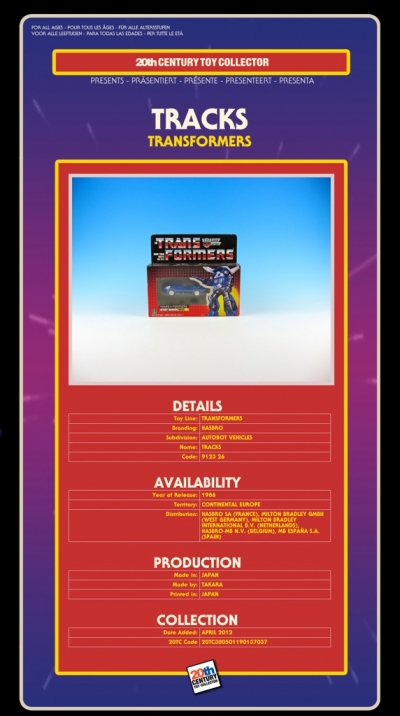
So what’s this to you? Well first of all, if you’re a collector to whom all this stuff applies as well I hope to have a least inspired you to undertake similiar steps in getting your collection organized and insured. The second reason is that while I was spending countless of man hours recording information about my collection I thought it would be a great idea to share at least parts of the info I have recorded about my collection on my website. I know I love browsing through people’s vintage toy collections online and I would love it if someone got that same kick from browsing through my collection. Although some of the info in my database I like to keep private (price paid, name of the seller etc) there’s still a lot of info in there that would be nice to share like the photographs of the items themselves, year of release, production/catalog numbers, names of distributors etc. That’s why I have decided to unlock parts of my database to the visitors of this website.
“Programming, Programming, Programming…”
Besides the countless hours I have invested in photographing and recording my collection items I have also spent way too much of my spare time in programming a public front end to my collection database. For the techies among you, the database is a mySQL instance with a PHP interface that I programmed to serve the data in HTML form. I plan to release the data in three phases. The first phase will go live as of today and will allow me to link to specific items in my collection database. Basically this means that whenever I do a blog post on a certain item in my collection I will add a link to the corresponding database entry in the form of a button that you can click on. Here’s an example:

Marshal Bravestarr (1987)
If you click on the button above you will be taken to the actual database record of the Marshal Bravestarr action figure in my collection. Cool, huh? :-) The second phase of this project will involve an update of the “Spotlight” widget on my site. As regular visitors will know there’s a widget at the top of every page on my site that shows a random item from my collection each time you visit a page on my site. Currently this just links to a photo of the item being shown. The second phase will go into effect as soon as I have 50 items in my database which are properly tagged with meta data. From that moment on the Spotlight widget will link to the actual database entry of the item being shown. This means that whenever you click on a Spotlight item you will be taken directly to the database record of said item.
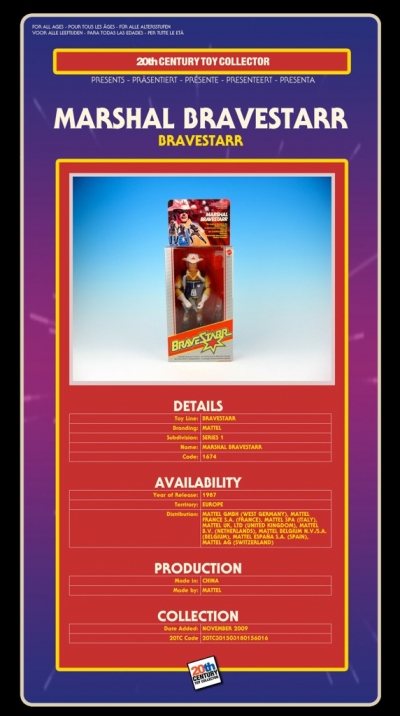
That’s all and well, but the most interesting thing will be when I reach the third and last phase, which is when all my collection items have been recorded in the database. At that point I will attempt to program a front end that will allow you direct access to all the items in my collection instead of just random items. I plan to create a portal that will list all the toy lines I have in my collection. When you select a toy line you will be able to browse each and every item I have of said toy line, i.e. my complete collection will be browsable online.
“Beta”
Things are very much in an experimental phase right now, so don’t be surprised if something goes wrong or some data is incorrect. Also, programming for all the different browsers out there is still a pain in the ass (Internet Explorer, I’m looking at you). The collection pages should look fine on browsers like Firefox, Safari, Chrome and on mobile browsers like Safari on iOS. Internet Explorer currently has some issues rendering some of the fonts correctly, which I hope to solve in the near future. I will also continue to polish the program code and add more info as I progress, like comments, catalog photos of items and anything else that I think is interesting to share.
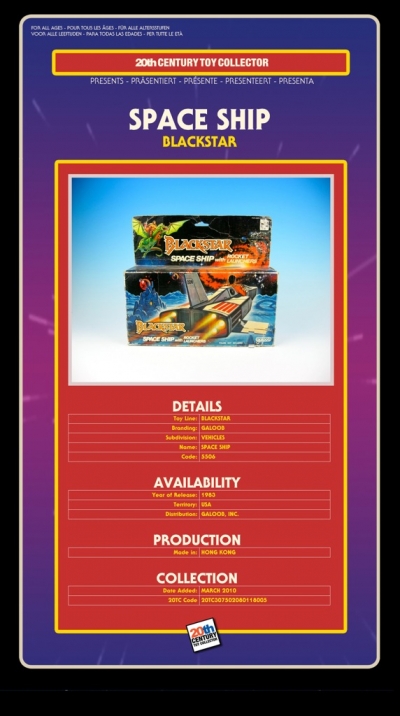
I will keep you updated with my progress and I will also report my experiences in trying to deal with insurance companies in my quest to insure my collection. I hope that some of this info will come in handy for some of you and that it might help you in your endeavours to get your collection insured. Peace of mind is worth a lot these days. If you have any questions or suggestions just leave them in the comments section or email me directly. Happy collecting!






































































































